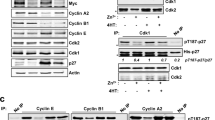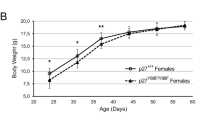Abstract
To study the oncogenic activity of cyclin E in an in vivo system we generated transgenic mice expressing high levels of cyclin E in T-lymphocytes by using a construct containing the CD2 locus control region. These animals were neither predisposed to develop any tumors spontaneously nor showed an increased incidence when crossbred with Eμ L-myc transgenic mice but developed hyperplasia in peripheral lymphoid organs at later age with an incidence of 27%. When treated with the DNA methylating carcinogen N-methylnitrosourea (MNU) that provokes the development of T-cell lymphomas, CD2-cyclin E transgenic animals came down with T-cell neoplasia showing a significant higher incidence (54%) than normal non transgenic controls (31%). In one of eight tumors that arose in normal MNU treated mice we could find an expected activating point mutation in the Ki-ras gene (12.5%). In contrast, the same mutation occurred in five of 16 tumors from CD2-cyclin E transgenic mice (31.2%). Whereas cyclin E overexpression alone did not lead to an increased CDK2 activity we observed in all tumors that emerged from either MNU treated normal mice or treated CD2-cyclin E transgenics a downregulation of p27KIP1 and a higher histone H1 kinase activity in CDK2 immunoprecipitates compared to normal tissue. These findings demonstrate that high level expression of cyclin E can predispose T-cells for hyperplasia and malignant transformation. However, the results also suggest that this activity of cyclin E is manifest only when other cooperating oncogenes in particular ras genes are present and activated. This would be consistent with our previous finding that cyclin E and Ha-Ras cooperate in focus formation assays in rat embryo fibroblasts.
This is a preview of subscription content, access via your institution
Access options
Subscribe to this journal
Receive 50 print issues and online access
$259.00 per year
only $5.18 per issue
Buy this article
- Purchase on Springer Link
- Instant access to full article PDF
Prices may be subject to local taxes which are calculated during checkout







Similar content being viewed by others
References
Alevizopoulos K, Vlach J, Hennecke S and Amati B. . 1997 EMBO J. 16: 5322–5333.
Bartek J, Bartkova J and Lukas J. . 1996 Curr. Opin. Cell Biol. 8: 805–814.
Bortner DM and Rosenberg MP. . 1997 Mol. Cell Biol. 17: 453–459.
Buckley MF, Sweeney KJ, Hamilton JA, Sini RL, Manning DL, Nicholson RI, deFazio A, Watts CK, Musgrove EA and Sutherland RL. . 1993 Oncogene 8: 2127–2133.
DeGregori J, Kowalik T and Nevins JR. . 1995 Mol. Cell Biol. 15: 4215–4224.
Donnellan R and Chetty R. . 1999 FASEB J. 13: 773–780.
Dulic V, Lees E and Reed SI. . 1992 Science 257: 1958–1961.
Erlanson M, Portin C, Linderholm B, Lindh J, Roos G and Landberg G. . 1998 Blood 92: 770–777.
Haas K, Johannes C, Geisen C, Schmidt T, Karsunky H, Blass-Kampmann S, Obe G and Möröy T. . 1997 Oncogene 15: 2615–2623.
Hall M, Bates S and Peters G. . 1995 Oncogene 11: 1581–1588.
Harper JW and Elledge SJ. . 1996 Curr. Opin. Genet. Dev. 6: 56–64.
Hogan B, Beddington R, Costantini F and Lacy E. . 1994 Manipulating the Mouse Embryo. CSH-Laboratory Press.
Joshi VV and Frei JV. . 1970 J. Natl. Cancer Inst. 44: 185–208.
Keyomarsi K and Pardee AB. . 1993 Proc. Natl. Acad. Sci. USA 90: 1112–1116.
Keyomarsi K, Conte D, Toyofuku W and Fox MP. . 1995 Oncogene 11: 941–950.
Koff A, Cross F, Fisher A, Schumacher J, Leguellec K, Philippe M and Roberts JM. . 1991 Cell 66: 1217–1228.
Koff A, Giordano A, Desai D, Yamashita K, Harper JW, Elledge S, Nishimoto T, Morgan DO, Franza BR and Roberts JM. . 1992 Science 257: 1689–1694.
LaBaer J, Garrett MD, Stevenson LF, Slingerland JM, Sandhu C, Chou HS, Fattaey A and Harlow E. . 1997 Genes Dev. 11: 847–862.
Liu L, Allay E, Dumenco LL and Gerson SL. . 1994 Cancer Res. 54: 4648–4652.
Lovec H, Grzeschiczek A, Kowalski MB and Möröy T. . 1994 EMBO J. 13: 3487–3495.
Lukas J, Herzinger T, Hansen K, Moroni MC, Resnitzky D, Helin K, Reed SI and Bartek J. . 1997 Genes Dev. 111: 1479–1492.
Morgan DO. . 1995 Nature 374: 131–134.
Möröy T, Fisher P, Guidos C, Ma A, Zimmerman K, Tesfaye A, DePinho R, Weissman I and Alt FW. . 1990 EMBO J. 9: 3659–3666.
Möröy T, Grzeschiczek A, Petzold S and Hartmann KU. . 1993 Proc. Natl. Acad. Sci. USA 90: 10734–10738.
Newcomb EW, Corominas M, Bayona W and Pellicer A. . 1989 Anticancer Res. 9: 1407–1416.
Newcomb EW, Bayona W and Pisharody S. . 1995 Mol. Carcinog. 13: 89–95.
Nourse J, Firpo E, Flanagan WM, Coats S, Polyak K, Lee MH, Massague J, Crabtree GR and Roberts JM. . 1994 Nature 372: 570–573.
Ohtani K, DeGregori J and Nevins JR. . 1995 Proc. Natl. Acad. Sci. USA 92: 12146–12150.
Ohtsubo M, Theodoras AM, Schumacher J, Roberts JM and Pagano M. . 1995 Mol. Cell Biol. 15: 2612–2624.
Planas-Silva MD and Weinberg RA. . 1997 Curr. Opin. Cell Biol. 9: 768–772.
Polyak K, Kato JY, Solomon MJ, Sherr CJ, Massague J, Roberts JM and Koff A. . 1994 Genes Dev. 8: 9–22.
Reynisdottir I, Polyak K, Iavarone A and Massague J. . 1995 Genes Dev. 9: 1831–1845.
Resnitzky D and Reed SI. . 1995 Mol. Cell Biol. 15: 3463–3469.
Sambrook J, Fritsch EF and Maniatis T. . 1989 Molecular Cloning – A Laboratory Manual. Cold Spring Harbor: Laboratory Press.
Schmidt T, Karsunky H, Rödel B, Zevnik B, Elsässer HP and Möröy T. . 1998 EMBO J. 18: 5349–5359.
Sewing A, Bürger C, Brüsselbach S, Schalk C, Lucibello FC and Müller R. . 1993 J. Cell Sci. 104: 545–555.
Sgambato A, Han EK-H, Zhou P, Schieren I and Weinstein IB. . 1996 Cancer Res. 56: 1389–1399.
Sherr CJ and Roberts JM. . 1995 Genes Dev. 9: 1149–1163.
Sherr CJ. . 1993 Cell 73: 1059–1065.
Sweeney KJ, Swarbrick A, Sutherland RL and Musgrove EA. . 1998 Oncogene 16: 2865–2878.
Weinberg RA. . 1996 Cell 85: 457–459.
Wolowiec D, Benchaib M, Pernas P, Deviller P, Souchier C, Rimokh R, Felman P, Bryon PA and Ffrench M. . 1995 Leukemia 9: 1382–1388.
Zaidi NH, Pretlow TP, O'Riordan MA, Dumenco LL, Allay E and Gerson SL. . 1995 Carcinog. 16: 451–456.
Zarkowska T and Mittnacht S. . 1997 J. Biol. Chem. 272: 12738–12746.
Zhumabekov T, Corbella P, Toliani M and Kioussis D. . 1995 J. Immunol. Meth. 185: 133–140.
Acknowledgements
This work was supported by grants of the Deutsche Forschungsgemeinschaft (Mo 435/11-1), the Dr Mildred Scheel Stiftung für Krebsforschung and the Fonds der chemischen Industrie.
Author information
Authors and Affiliations
Rights and permissions
About this article
Cite this article
Karsunky, H., Geisen, C., Schmidt, T. et al. Oncogenic potential of cyclin E in T-cell lymphomagenesis in transgenic mice: evidence for cooperation between cyclin E and Ras but not Myc. Oncogene 18, 7816–7824 (1999). https://doi.org/10.1038/sj.onc.1203205
Received:
Revised:
Accepted:
Published:
Issue Date:
DOI: https://doi.org/10.1038/sj.onc.1203205
Keywords
This article is cited by
-
A Novel Model of SCID-X1 Reconstitution Reveals Predisposition to Retrovirus-induced Lymphoma but No Evidence of γC Gene Oncogenicity
Molecular Therapy (2009)
-
Post-translational modification and stability of low molecular weight cyclin E
Oncogene (2009)
-
Deregulated cyclin E promotes p53 loss of heterozygosity and tumorigenesis in the mouse mammary gland
Oncogene (2006)
-
Cyclin E in normal and neoplastic cell cycles
Oncogene (2005)
-
Loss of p27Kip1 cooperates with cyclin E in T-cell lymphomagenesis
Oncogene (2003)



